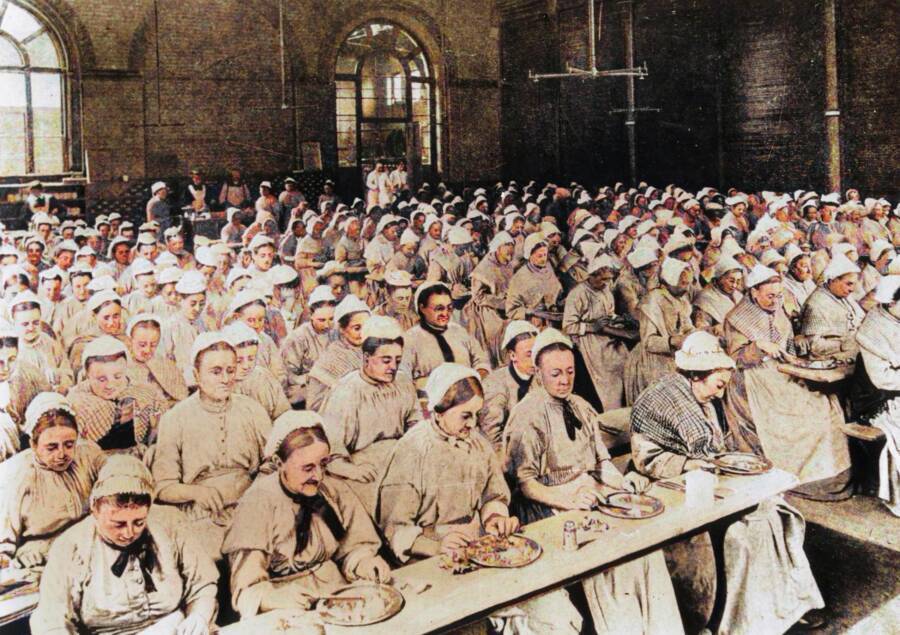Though London's St. Pancras Workhouse became so notorious that some have linked it to Charles Dickens' Oliver Twist, excavations suggest that it was originally intended to support and comfort its inhabitants.

MOLAArchaeologists believe that despite the historic reputation of workhouses, some were originally places of support and care.
The depiction of English workhouses in novels like Oliver Twist by Charles Dickens are generally grim. But excavations of the St. Pancras Workhouse in London have suggested that despite their reputation, some of these facilities were originally intended to be places of comfort.
Museum of London Archaeology project manager Gwilym Williams told The Guardian that discoveries at the site include brightly colored walls, fireplaces, and plates proudly stamped with an image of St. Pancras, the patron saint of children, jobs, and health. Williams says these findings paint “a very different picture compared with the dark, dingy workhouses often depicted in popular culture.”
Excavations of the workhouse have focused on areas that were demolished after bombings during World War II, according to the BBC. In what was likely once the female ward, archaeologists found well-preserved walls “standing up to a meter high, coated in vibrant blue painted plaster,” suggesting that residents at St. Pancras were not living in grim spaces.
They also uncovered dishes bearing the image of St. Pancras alongside the words “Guardians of the Poor St. Pancras Middlesex,” as well as items like a ceramic hot water bottle and a bone toothbrush with horsehair bristles.
“While the facilities are spartan, the inmates were not there to be punished,” Williams explained, according to The Guardian. “There were gardens, an infirmary and nursery. These acknowledge their needs as much as the heated rooms, or the pale blue paint on the walls.”
Williams added, “These discoveries allow us to get a vivid picture of life in early 19th century workhouses.”

MOLAExcavations of the St. Pancras Workhouse have revealed things like vibrant blue walls, which belie the reputation of workhouses as grim and dingy places.
St. Pancras first opened in 1809 and was meant to house 500 people. But by the 1850s, almost 2,000 people lived there. As The Guardian explains, residents received food and shelter but also had to work difficult and repetitive jobs like oakum picking and stone breaking.
Such an environment is depicted in Charles Dickens’ novel Oliver Twist (1838). When Oliver arrives at a workhouse, he encounters two men who explain what awaits him.
“‘Well! You have come here to be educated, and taught a useful trade,’ said the red-faced gentleman in the high chair.
‘So you’ll begin to pick oakum to-morrow morning at six o’clock,’ added the surly one in the white waistcoat.”
Dickens writes that Oliver is then “hurried away to a large ward; where, on a rough, hard bed, he sobbed himself to sleep.”
And, indeed, some have drawn a connection between St. Pancras and the classic novel. The BBC writes that Dickens possibly based the character of Oliver Twist on Robert Blincoe, a real boy who lived and worked at St. Pancras.
“Robert Blincoe… was a child inmate of the workhouse, which was overcrowded and bug-ridden,” workhouse historian Peter Higginbotham explained, according to The Guardian. “As well as being given a rudimentary education, Blincoe and his fellow inmates were sometimes set to work for 12 hours a day or more at the unpleasant task of oakum picking.”
That said, it’s not clear that Dickens based his novel on St. Pancras in particular. Though Williams suggested that this was the case, The Guardian noted that previous research has suggested that Dickens actually drew inspiration from the Cleveland Street Workhouse.

General Photographic Agency/Getty ImagesWomen eating a meal at St. Pancras Workhouse. Circa 1900.
In 1929, the workhouse became part of St. Pancras Hospital, but large parts of it were destroyed during a World II bombing. Now, the site is set to become a center for for eye care, research, and education called Oriel, which is due to open in 2027.
Dr. Leon Litvack, the principal editor of the Charles Dickens Letters Project, told The Guardian that it’s comforting that the site will be used to help people moving forward.
“It’s ironic, but heartening nevertheless, that a location where such abuses took place is being transformed into a modern new eye care centre, which will, we trust, look after those it treats better than was the case over 160 years ago,” Litvack said.
After reading about the surprising discoveries made during the excavation of a former Victorian London workhouse, enjoy these colorized photos of Victorian London that show what life was really like. Or, discover the strange story of the Great Smog of London that killed 12,000 people.





